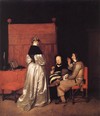Final Flashcards

Frans Hals (1580–1666), Banquet of the Officers of the St. George Civic Company, 1616.
Oil on canvas, Frans Halsmuseum, Haarlem

Gerrit Dou (1613‒1675), The Quack, 1652.
Oil on panel, Museum Boijmans Van Beuningen, Rotterdam

Jan Steen (1626–1679), Self-Portrait as a Lutenist, ca. 1660.
Oil on canvas, Museo Thyssen-Bornemisza, Madrid

Jan Steen (1626–1679), As the Old Sing, So the Young Pipe, ca. 1663.
Oil on panel, Royal Picture Gallery Mauritshuis, The Hague
a celebration of the baptism of the baby at center as an occasion to demonstrate the effects of errant adult behavior on impressionable youngsters

Gerard Terborch (1617–1681), Gallant Conversation (“The Parental Admonition”), 1654–1655.
Oil on canvas, Staatliche Museen, Berlin

Thomas de Keyser (ca. 1596/7–1667), Constantijn Huygens and His Clerk, 1627.
Oil on canvas, National Gallery, London

Rembrandt (1606–1669), The Artist in His Studio, ca. 1626‒1628.
Oil on panel, Museum of Fine Arts, Boston

Rembrandt (1606–1669), The Anatomy Lesson of Dr. Tulp, 1632.
Oil on canvas, Mauristhuis, The Hague

Rembrandt (1606–1669), The Night Watch or The Militia Company of Captain Frans Banning Cocq, 1642.
Oil on canvas, Rijksmuseum, Amsterdam

Rembrandt (1606–1669), Jan Six, ca. 1654.
Oil on canvas, Six Collection, Amsterdam

Rembrandt (1606–1669), Self-Portrait, ca. 1663–1665.
Oil on canvas, Kenwood House, London

Rembrandt (1606–1669), Lucretia, 1666.
Oil on canvas, Institute of Arts, Minneapolis

Johannes Vermeer (1632–1675), The Milkmaid, ca. 1658.
Oil on canvas Rijksmuseum, Amsterdam

Johannes Vermeer (1632–1675), The Art of Painting, ca. 1666.
Oil on canvas, Kunsthistorisches Museum, Vienna

Johannes Vermeer (1632–1675), View of Delft (1632–1675), ca. 1660.
Oil on canvas, Mauritshuis, The Hague

Jacob Isaacksz van Ruisdael (or Ruysdael) (ca. 1629–1682), Bentheim Castle, 1653.
Oil on canvas, National Gallery of Ireland, Dublin

Jacob Isaackzn van Ruisdael (ca. 1629–1682), The Jewish Cemetery, ca. 1655.
Oil on canvas, Institute of Arts, Detroit

Inigo Jones (1573–1652), The Banqueting House, Whitehall, London, begun 1619

Peter Paul Rubens (1577–1640), The Apotheosis of James I, 1630–1634.
Banqueting House, Whitehall, London

Christopher Wren (1632–1723), St. Paul’s Cathedral, London, construction began in 1675, completed 1711
Patronage
direct influence in how works were produced, collaborations with royal patrons,
religious theme matter– Catholics until the 17th C, then the Reformation and Protestantism
Rise of the Middle Class
changing social and political aspects. the predominant styles of painting changed to reflect their tastes and knowledge, rouw and net/grand styles
Genre painting
end of 17th sees explosion in landscape, still lives, quotidien scenes, moral content
Specialization
artists that specialize in one specific thing like church interiors, cows, etc.


